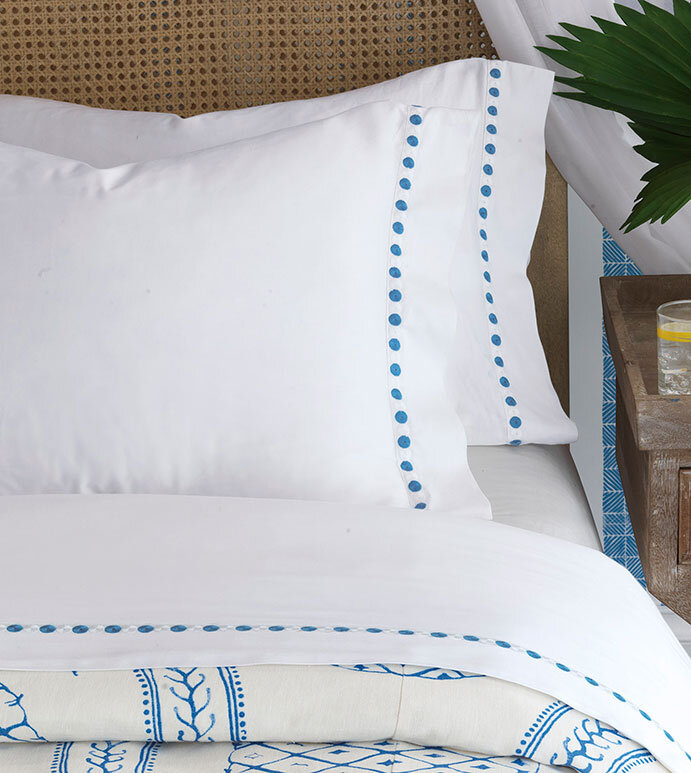Your Thread Count Might be Killing You!
Okay, we lied. We're not aware of anyone being killed by their thread count. But lying is exactly what your sheet manufacturer might be doing. Did you know that a thread count above 500 should be met with a heavy dose of skepticism and is probably totally inaccurate?
Some companies cheat on their thread count, which is the number of threads per square inch, by counting every ply in a single piece of thread. Imagine you have a thread count of 400 with long, strong, single-ply fibers. An honest manufacturer will come to the number 400 by counting 200 vertical threads and 200 horizontal threads in that square inch. Another company might twist two weak, short threads together to make one double-ply fiber and instead of just counting 200 vertical and 200 horizontal, they double the number and give their sheets a thread count of 800. In reality, it's still 400 just with shorter, cheaper, multi-ply fibers. How do you know if you're getting a true thread count and not some inflated version? Make sure your sheets are made with single-ply yarns and high-quality Egyptian, pima or supima long-staple or extra-long-staple cotton. Here's how it all works:
The Materials: The Longer Staple the Better
It starts with the raw materials. For the softest sheets that will stand up to wear and tear, you want to look for long-staple or extra-long-staple cotton. Staple means fiber and the longer the staple, the softer, more breathable and more durable the final product will be. Long-staple cotton has been around for over a century while extra-long-staple (ESL) cotton is a relatively newer concept. Though ESL cotton will give you the most sumptuous sheets and is considered premium, long-staple cotton is your best bet for relatively affordable bedding that still has a luxury feel. Since longer-staple cottons can be spun into strong, fine yarns, it produces sheets with a smooth, soft, tight weave. Cheaper sheets made with short-staple cottons tend to be coarse and the fabric is weaker due to the short staples poking out of the weave. Most manufacturers who use short-staple cotton won't label their products as such. Instead, it will just say "100% cotton" with no indication of the staple length. Always look at the package carefully.
Ply: Less is More
Our favorite Soho bedding from one of our custom linen sources. It comes in tons of colors! Available for purchase.
The Soho bedding in action. Here they complete the bedding ensemble for one of our clients.
The term ply doesn’t just refer to toilet paper. While multi-ply sounds better, a high-quality sheet will be woven from single-ply threads using the aforementioned long-staple or extra-long-staple cotton. Single-ply threads create softer sheets that are more durable. Multi-ply threads involve weaker fibers (usually from inexpensive, low-quality, shorter-staple cotton or synthetic materials) woven together in groups to make one thread as they're not strong enough to stand alone. The sheets end up being scratchy and heavy.
Percale Versus Sateen
Now on to the weave. When shopping for cotton sheets, you’ve probably noticed they come in percale or sateen. These are the weaves and they influence how the fabric feels and looks. Percale sheets are cool and crisp to the touch with a matte finish. They're easy to care for, wash well, can last for a really long time and are extremely breathable, however, they do wrinkle easily. This weave is great for summer, people who tend to get sweaty or overheated in their sleep and warmer climates. Sateen has a slight sheen, a smooth, silky feel because more thread surface is exposed and are a bit denser than percale, which is why they're a good option for cooler weather. Sateen sheets are less wrinkle prone and drape beautifully but they often lose some of their luster over time and are susceptible to pilling. The type of weave really comes down to personal preference.
Bottom Line
Egyptian cotton sheets by Eastern Accents
As you can see, thread count isn't the final word in the world of linens. It's important but there are a lot of factors that determine how soft sheets are and how long they’ll last. That being said, before you disregard thread count altogether, know that as you drop below 250, the sheets will start to feel a little coarse so it's worth it to invest in a thread count between 250 and 500. Anything higher is most likely a gimmick. When it comes to quality sheets, price does matter. Unfortunately, those $30 800 thread count sheets really are too good to be true. Shell out a little more for linens with a realistic thread count crafted from long-staple cotton and you'll be sleeping comfortably for years to come.





